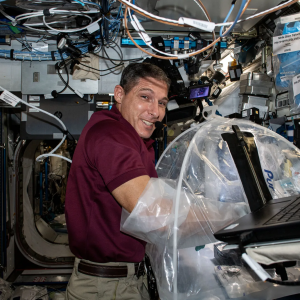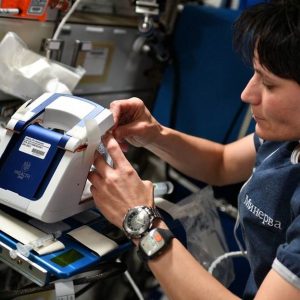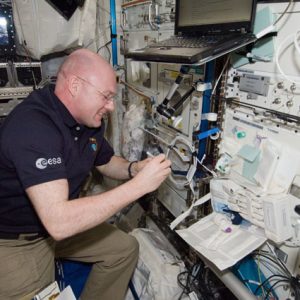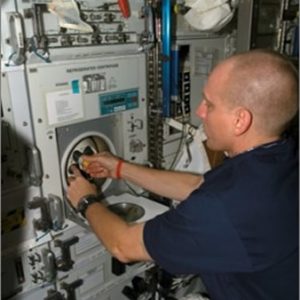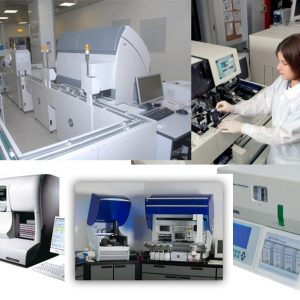In-Flight Lab Analysis
The Challenge
The Challenge is to develop the medical diagnostic capabilities used in hospital laboratories by “shrinking” the technology to accommodate long duration space flight.
The Research
The Human Research Program (HRP) is addressing near term research risks such as inadequate nutrition, bone degradation, loss of cardiovascular function, etc. and aims to reduce the need for biological sample return (frozen blood samples) since retirement of the Space Shuttle by developing in-situ research laboratory analysis capability for the International Space Station.
The Exploration Medical Capabilities (ExMC) Element of HRP is leveraging the Human Health Countermeasures development effort for required medical diagnostics capability to enable the recognition and treatment of several medical conditions (ExMC Gap 4.05) required for human Space Exploration.
The Progress
Currently, space diagnostic technology for blood analysis has been developed that requires small sample volume, performs multiple clinical panels and fits in your hand. However, challenges including limited shelf life of 6 months, refrigeration needs and data reliability issues still exist. Other technologies are also being developed in collaboration with our Small Business Innovation Research (SBIR) initiatives. HRP is also working with Mars Campaign Office’s exploration medical integrated product team (XM-IPT) to prioritize commercially available technologies for technology demonstration in low earth orbit or on parabolic flight campaigns. Previous technology demonstrations completed on the ISS include the HemoCue and rHealth ONE. Additional information on how the rHEALTH flow cytometry technology was modified to work in a spaceflight environment can be found here.
Acronyms
ExMC – Exploration Medical Capabilities
HRP – Human Research Program
SBIR – Small Business Innovation Research
rHEALTH – Reusable Handheld Electrolytes and Lab Technology for Humans
XM-IPT – Exploration Medical Integrated Product Team
In-Flight Lab Analysis Gaps
What is an HRP Gap?
Evidence from medical records, spaceflight operations and research findings provides the basis for identifying the most significant human risks in space exploration, including physiological and performance effects from hazards such as altered gravity, radiation, hostile/closed environments, isolation and distance. Each risk is assigned to an HRP Element (divisions of human research) to identify knowledge gaps, or the critical questions that must be answered, in order to mitigate the risk. These gaps become the focus of research conducted to reduce the likelihood and consequence of risks becoming a reality. To learn more about the Risk Identification and Mitigation process and the tasks developed to reduce those risks for the program please select the links below the for more information.
4.05 Measure Lab Analytes
4.06 Bone Fractures
4.08 Muscular Injuries
4.17 Pharmacological Efficacy
IM3 Immune Dysregulation
Gallery
Cardiovascular Impacts
What are the in-flight alterations in cardiac structure and function?
Evidence from medical records, spaceflight operations and research findings provides the basis for identifying the most significant human risks in space exploration, including physiological and performance effects from hazards such as altered gravity, radiation, hostile/closed environments, isolation and distance. Each risk is assigned to an HRP Element (divisions of human research) to identify knowledge gaps, or the critical questions that must be answered, in order to mitigate the risk. These gaps become the focus of research conducted to reduce the likelihood and consequence of risks becoming a reality. To learn more about the Risk Identification and Mitigation process and the tasks developed to reduce those risks for the program please click on the link below the gap for more information.
Measuring VO2 inflight
What is VO2max in-flight and immediately post-flight?
Evidence from medical records, spaceflight operations and research findings provides the basis for identifying the most significant human risks in space exploration, including physiological and performance effects from hazards such as altered gravity, radiation, hostile/closed environments, isolation and distance. Each risk is assigned to an HRP Element (divisions of human research) to identify knowledge gaps, or the critical questions that must be answered, in order to mitigate the risk. These gaps become the focus of research conducted to reduce the likelihood and consequence of risks becoming a reality. To learn more about the Risk Identification and Mitigation process and the tasks developed to reduce those risks for the program please click on the link below the gap for more information.
Predicting Heart Disease
Can manifestations of sub-clinical or environmentally induced cardiovascular diseases during spaceflight be predicted?
Evidence from medical records, spaceflight operations and research findings provides the basis for identifying the most significant human risks in space exploration, including physiological and performance effects from hazards such as altered gravity, radiation, hostile/closed environments, isolation and distance. Each risk is assigned to an HRP Element (divisions of human research) to identify knowledge gaps, or the critical questions that must be answered, in order to mitigate the risk. These gaps become the focus of research conducted to reduce the likelihood and consequence of risks becoming a reality. To learn more about the Risk Identification and Mitigation process and the tasks developed to reduce those risks for the program please click on the link below the gap for more information.
Outcome of Medical Events
We do not know the quantified health and mission outcomes due to medical events during exploration missions.
Evidence from medical records, spaceflight operations and research findings provides the basis for identifying the most significant human risks in space exploration, including physiological and performance effects from hazards such as altered gravity, radiation, hostile/closed environments, isolation and distance. Each risk is assigned to an HRP Element (divisions of human research) to identify knowledge gaps, or the critical questions that must be answered, in order to mitigate the risk. These gaps become the focus of research conducted to reduce the likelihood and consequence of risks becoming a reality. To learn more about the Risk Identification and Mitigation process and the tasks developed to reduce those risks for the program please click on the link below the gap for more information.
Doctor on Board?
We do not know how the inclusion of a physician crew medical officer quantitatively impacts medical risk during exploration missions.
Evidence from medical records, spaceflight operations and research findings provides the basis for identifying the most significant human risks in space exploration, including physiological and performance effects from hazards such as altered gravity, radiation, hostile/closed environments, isolation and distance. Each risk is assigned to an HRP Element (divisions of human research) to identify knowledge gaps, or the critical questions that must be answered, in order to mitigate the risk. These gaps become the focus of research conducted to reduce the likelihood and consequence of risks becoming a reality. To learn more about the Risk Identification and Mitigation process and the tasks developed to reduce those risks for the program please click on the link below the gap for more information.
Microgravity Countermeasures
How does 1/6-g and 3/8-g influence countermeasures?
Evidence from medical records, spaceflight operations and research findings provides the basis for identifying the most significant human risks in space exploration, including physiological and performance effects from hazards such as altered gravity, radiation, hostile/closed environments, isolation and distance. Each risk is assigned to an HRP Element (divisions of human research) to identify knowledge gaps, or the critical questions that must be answered, in order to mitigate the risk. These gaps become the focus of research conducted to reduce the likelihood and consequence of risks becoming a reality. To learn more about the Risk Identification and Mitigation process and the tasks developed to reduce those risks for the program please click on the link below the gap for more information.
Efficient Exercise Regimen
Develop the most efficient and effective exercise program for the maintenance of muscle function.
Evidence from medical records, spaceflight operations and research findings provides the basis for identifying the most significant human risks in space exploration, including physiological and performance effects from hazards such as altered gravity, radiation, hostile/closed environments, isolation and distance. Each risk is assigned to an HRP Element (divisions of human research) to identify knowledge gaps, or the critical questions that must be answered, in order to mitigate the risk. These gaps become the focus of research conducted to reduce the likelihood and consequence of risks becoming a reality. To learn more about the Risk Identification and Mitigation process and the tasks developed to reduce those risks for the program please click on the link below the gap for more information.
Minimum Exercise Needed?
What is the minimum exercise regimen needed to maintain fitness levels for tasks?
Evidence from medical records, spaceflight operations and research findings provides the basis for identifying the most significant human risks in space exploration, including physiological and performance effects from hazards such as altered gravity, radiation, hostile/closed environments, isolation and distance. Each risk is assigned to an HRP Element (divisions of human research) to identify knowledge gaps, or the critical questions that must be answered, in order to mitigate the risk. These gaps become the focus of research conducted to reduce the likelihood and consequence of risks becoming a reality. To learn more about the Risk Identification and Mitigation process and the tasks developed to reduce those risks for the program please click on the link below the gap for more information.
Exercise Hardware
Identify and validate exploration countermeasure hardware for the maintenance of muscle function.
Evidence from medical records, spaceflight operations and research findings provides the basis for identifying the most significant human risks in space exploration, including physiological and performance effects from hazards such as altered gravity, radiation, hostile/closed environments, isolation and distance. Each risk is assigned to an HRP Element (divisions of human research) to identify knowledge gaps, or the critical questions that must be answered, in order to mitigate the risk. These gaps become the focus of research conducted to reduce the likelihood and consequence of risks becoming a reality. To learn more about the Risk Identification and Mitigation process and the tasks developed to reduce those risks for the program please click on the link below the gap for more information.
Time Course of Changes in Muscle
Characterize the time course of changes in muscle protein turnover, muscle mass, and function during long duration space flight.
Evidence from medical records, spaceflight operations and research findings provides the basis for identifying the most significant human risks in space exploration, including physiological and performance effects from hazards such as altered gravity, radiation, hostile/closed environments, isolation and distance. Each risk is assigned to an HRP Element (divisions of human research) to identify knowledge gaps, or the critical questions that must be answered, in order to mitigate the risk. These gaps become the focus of research conducted to reduce the likelihood and consequence of risks becoming a reality. To learn more about the Risk Identification and Mitigation process and the tasks developed to reduce those risks for the program please click on the link below the gap for more information.
Bone Health Standard
A new acceptable bone health standard using an expanded surrogate for bone health needs to be defined for the flight environment.
Evidence from medical records, spaceflight operations and research findings provides the basis for identifying the most significant human risks in space exploration, including physiological and performance effects from hazards such as altered gravity, radiation, hostile/closed environments, isolation and distance. Each risk is assigned to an HRP Element (divisions of human research) to identify knowledge gaps, or the critical questions that must be answered, in order to mitigate the risk. These gaps become the focus of research conducted to reduce the likelihood and consequence of risks becoming a reality. To learn more about the Risk Identification and Mitigation process and the tasks developed to reduce those risks for the program please click on the link below the gap for more information.
Osteoporosis & Fractures
What is the incidence & prevalence of early onset osteoporosis or fragility fractures due to exposure to spaceflight.
Evidence from medical records, spaceflight operations and research findings provides the basis for identifying the most significant human risks in space exploration, including physiological and performance effects from hazards such as altered gravity, radiation, hostile/closed environments, isolation and distance. Each risk is assigned to an HRP Element (divisions of human research) to identify knowledge gaps, or the critical questions that must be answered, in order to mitigate the risk. These gaps become the focus of research conducted to reduce the likelihood and consequence of risks becoming a reality. To learn more about the Risk Identification and Mitigation process and the tasks developed to reduce those risks for the program please click on the link below the gap for more information.
Ocular changes
We do not know the etiological mechanisms and contributing risk factors for ocular structural and functional changes seen in-flight and post-flight.
Evidence from medical records, spaceflight operations and research findings provides the basis for identifying the most significant human risks in space exploration, including physiological and performance effects from hazards such as altered gravity, radiation, hostile/closed environments, isolation and distance. Each risk is assigned to an HRP Element (divisions of human research) to identify knowledge gaps, or the critical questions that must be answered, in order to mitigate the risk. These gaps become the focus of research conducted to reduce the likelihood and consequence of risks becoming a reality. To learn more about the Risk Identification and Mitigation process and the tasks developed to reduce those risks for the program please click on the link below the gap for more information.
Medical Event Risk Metrics
We need to characterize the medical conditions that can occur during exploration missions and their relevant associated end states, management options, and the capabilities necessary to manage them (what can happen, how bad could it be, what can we do to improve it?).
Evidence from medical records, spaceflight operations and research findings provides the basis for identifying the most significant human risks in space exploration, including physiological and performance effects from hazards such as altered gravity, radiation, hostile/closed environments, isolation and distance. Each risk is assigned to an HRP Element (divisions of human research) to identify knowledge gaps, or the critical questions that must be answered, in order to mitigate the risk. These gaps become the focus of research conducted to reduce the likelihood and consequence of risks becoming a reality. To learn more about the Risk Identification and Mitigation process and the tasks developed to reduce those risks for the program please click on the link below the gap for more information.
Integrated Exploration Medical System Models
We need to develop integrated exploration medical system models for the Moon and Mars.
Evidence from medical records, spaceflight operations and research findings provides the basis for identifying the most significant human risks in space exploration, including physiological and performance effects from hazards such as altered gravity, radiation, hostile/closed environments, isolation and distance. Each risk is assigned to an HRP Element (divisions of human research) to identify knowledge gaps, or the critical questions that must be answered, in order to mitigate the risk. These gaps become the focus of research conducted to reduce the likelihood and consequence of risks becoming a reality. To learn more about the Risk Identification and Mitigation process and the tasks developed to reduce those risks for the program please click on the link below the gap for more information.
Cardiovascular Impacts from Weightlessness
Determine whether long-duration weightlessness induces cardiovascular structural and functional changes and/or oxidative stress & damage (OSaD)/inflammation, that can contribute to development of disease.
Evidence from medical records, spaceflight operations and research findings provides the basis for identifying the most significant human risks in space exploration, including physiological and performance effects from hazards such as altered gravity, radiation, hostile/closed environments, isolation and distance. Each risk is assigned to an HRP Element (divisions of human research) to identify knowledge gaps, or the critical questions that must be answered, in order to mitigate the risk. These gaps become the focus of research conducted to reduce the likelihood and consequence of risks becoming a reality. To learn more about the Risk Identification and Mitigation process and the tasks developed to reduce those risks for the program please click on the link below the gap for more information.
Fluid Intake
Is it necessary to increase crew fluid intake and, if possible, to what extent will it mitigate stone formation?
Evidence from medical records, spaceflight operations and research findings provides the basis for identifying the most significant human risks in space exploration, including physiological and performance effects from hazards such as altered gravity, radiation, hostile/closed environments, isolation and distance. Each risk is assigned to an HRP Element (divisions of human research) to identify knowledge gaps, or the critical questions that must be answered, in order to mitigate the risk. These gaps become the focus of research conducted to reduce the likelihood and consequence of risks becoming a reality. To learn more about the Risk Identification and Mitigation process and the tasks developed to reduce those risks for the program please click on the link below the gap for more information.
Frequency of formation
What is the frequency of post-flight stone formation; the incidence and types of stones; and the time course of stone formation? How does stone formation correlate with food intake and hydration status?
Evidence from medical records, spaceflight operations and research findings provides the basis for identifying the most significant human risks in space exploration, including physiological and performance effects from hazards such as altered gravity, radiation, hostile/closed environments, isolation and distance. Each risk is assigned to an HRP Element (divisions of human research) to identify knowledge gaps, or the critical questions that must be answered, in order to mitigate the risk. These gaps become the focus of research conducted to reduce the likelihood and consequence of risks becoming a reality. To learn more about the Risk Identification and Mitigation process and the tasks developed to reduce those risks for the program please click on the link below the gap for more information.
Measure Lab Analytes
We do not have the capability to measure laboratory analytes in a minimally invasive manner during exploration missions.
Evidence from medical records, spaceflight operations and research findings provides the basis for identifying the most significant human risks in space exploration, including physiological and performance effects from hazards such as altered gravity, radiation, hostile/closed environments, isolation and distance. Each risk is assigned to an HRP Element (divisions of human research) to identify knowledge gaps, or the critical questions that must be answered, in order to mitigate the risk. These gaps become the focus of research conducted to reduce the likelihood and consequence of risks becoming a reality. To learn more about the Risk Identification and Mitigation process and the tasks developed to reduce those risks for the program please click on the link below the gap for more information.
Bone Fractures
We do not have the capability to stabilize bone fractures and accelerate fracture healing during exploration missions.
Evidence from medical records, spaceflight operations and research findings provides the basis for identifying the most significant human risks in space exploration, including physiological and performance effects from hazards such as altered gravity, radiation, hostile/closed environments, isolation and distance. Each risk is assigned to an HRP Element (divisions of human research) to identify knowledge gaps, or the critical questions that must be answered, in order to mitigate the risk. These gaps become the focus of research conducted to reduce the likelihood and consequence of risks becoming a reality. To learn more about the Risk Identification and Mitigation process and the tasks developed to reduce those risks for the program please click on the link below the gap for more information.
Muscular Injuries
We do not have the capability to optimally treat musculoskeletal injuries during exploration missions.
Evidence from medical records, spaceflight operations and research findings provides the basis for identifying the most significant human risks in space exploration, including physiological and performance effects from hazards such as altered gravity, radiation, hostile/closed environments, isolation and distance. Each risk is assigned to an HRP Element (divisions of human research) to identify knowledge gaps, or the critical questions that must be answered, in order to mitigate the risk. These gaps become the focus of research conducted to reduce the likelihood and consequence of risks becoming a reality. To learn more about the Risk Identification and Mitigation process and the tasks developed to reduce those risks for the program please click on the link below the gap for more information.
Pharmacological Efficacy
We do not have the capability to package medications to preserve stability and shelf-life during exploration missions.
Evidence from medical records, spaceflight operations and research findings provides the basis for identifying the most significant human risks in space exploration, including physiological and performance effects from hazards such as altered gravity, radiation, hostile/closed environments, isolation and distance. Each risk is assigned to an HRP Element (divisions of human research) to identify knowledge gaps, or the critical questions that must be answered, in order to mitigate the risk. These gaps become the focus of research conducted to reduce the likelihood and consequence of risks becoming a reality. To learn more about the Risk Identification and Mitigation process and the tasks developed to reduce those risks for the program please click on the link below the gap for more information.
Immune Dysregulation
We have not defined and validated a terrestrial human analog for spaceflight-associated immune system dysregulation.
Evidence from medical records, spaceflight operations and research findings provides the basis for identifying the most significant human risks in space exploration, including physiological and performance effects from hazards such as altered gravity, radiation, hostile/closed environments, isolation and distance. Each risk is assigned to an HRP Element (divisions of human research) to identify knowledge gaps, or the critical questions that must be answered, in order to mitigate the risk. These gaps become the focus of research conducted to reduce the likelihood and consequence of risks becoming a reality. To learn more about the Risk Identification and Mitigation process and the tasks developed to reduce those risks for the program please click on the link below the gap for more information.
Efficient Exercise Regimen
Develop the most efficient exercise program for maintenance of muscle fitness.
Evidence from medical records, spaceflight operations and research findings provides the basis for identifying the most significant human risks in space exploration, including physiological and performance effects from hazards such as altered gravity, radiation, hostile/closed environments, isolation and distance. Each risk is assigned to an HRP Element (divisions of human research) to identify knowledge gaps, or the critical questions that must be answered, in order to mitigate the risk. These gaps become the focus of research conducted to reduce the likelihood and consequence of risks becoming a reality. To learn more about the Risk Identification and Mitigation process and the tasks developed to reduce those risks for the program please click on the link below the gap for more information.
Minimum Exercise Needed?
What is the minimum exercise regimen needed to maintain fitness levels for tasks?
Evidence from medical records, spaceflight operations and research findings provides the basis for identifying the most significant human risks in space exploration, including physiological and performance effects from hazards such as altered gravity, radiation, hostile/closed environments, isolation and distance. Each risk is assigned to an HRP Element (divisions of human research) to identify knowledge gaps, or the critical questions that must be answered, in order to mitigate the risk. These gaps become the focus of research conducted to reduce the likelihood and consequence of risks becoming a reality. To learn more about the Risk Identification and Mitigation process and the tasks developed to reduce those risks for the program please click on the link below the gap for more information.
Exercise Hardware
Identify and validate exploration hardware for maintenance of muscle fitness.
Evidence from medical records, spaceflight operations and research findings provides the basis for identifying the most significant human risks in space exploration, including physiological and performance effects from hazards such as altered gravity, radiation, hostile/closed environments, isolation and distance. Each risk is assigned to an HRP Element (divisions of human research) to identify knowledge gaps, or the critical questions that must be answered, in order to mitigate the risk. These gaps become the focus of research conducted to reduce the likelihood and consequence of risks becoming a reality. To learn more about the Risk Identification and Mitigation process and the tasks developed to reduce those risks for the program please click on the link below the gap for more information.

